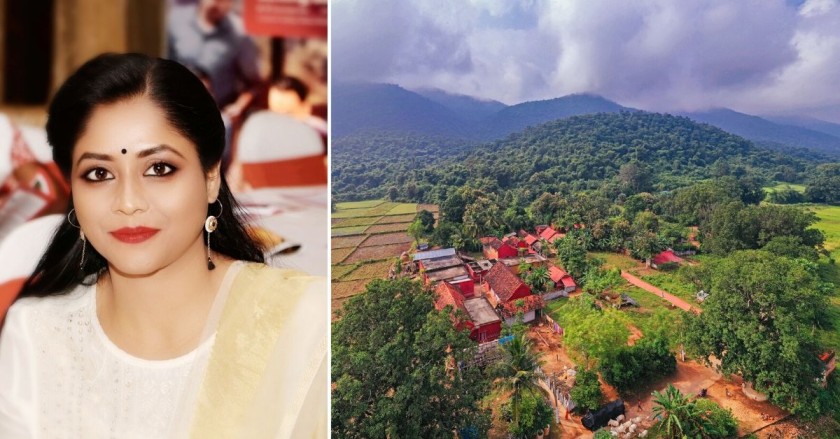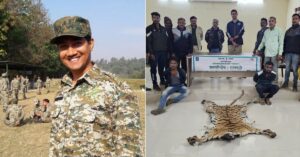Forest Officer Creates Odisha’s First Eco-Village, Helps Residents Earn Rs 2 Crore
With a strict zero-plastic policy, you won’t find a single person litter in this village. Here’s how the magic happened.

Situated on the banks of the Mahanadi river, and adjoining the Satkosia gorge, Muduligadia, a tiny hamlet in the Nayagarh district with barely thirty-five households holds a unique distinction. In 2019, it became the first village in Odisha to attain self-sustainability with zero-waste and 100% eco-friendly initiatives of livelihood.
One might find other eco-villages or experiential eco-resorts in Odisha. But what keeps Muduligadia a class apart is that it was the first ever hamlet to be remodelled into an eco-village exclusively by the community members. Their hard work and dedication deserve the sole credit for this incredible achievement.
Anshu Pragyan Das, the formal Divisional Forest Officer of Mahanadi Wildlife division was instrumental in spearheading this transition. Talking to The Better India, Anshu, the present Deputy Conservator of Forests (DCF) Ecotourism, reveals more details about the project.

Setting Up an Eco-Village in Odisha
Since 2016, the small villages around the Satkosia Tiger Reserve had been integrated into a Community Managed Nature Tourism programme. As a part of this project, around 45 ecotourism destinations were developed in the forested area, which was exclusively managed by the local villagers.
“These eco-tourism spots were generating considerable revenue for them, and they gradually became less dependent on forest products for earning their livelihood. The Odisha model of eco-tourism is the only existing community-based model in India where over 80% of the entire tourism revenue is returned to the community as wages, while the remaining 20% is invested for maintenance, upkeep and up-gradation of the tourist spots,” informs Anshu.
From this 80% revenue, around 10% was officially allocated to village development.

“So, after a while, a committee from the village approached me, seeking my advice on how to invest in developing their village. That’s when the idea of an eco-village crossed my mind,” says the officer, who is also an avid wildlife photographer and has authored two books.
Transforming a Community with Sustainability
Living in the buffer zone of Satkosia Tiger Reserve, Muduligadia’s residents have traditionally engaged in gathering forest resources like honey and timber. They used firewood for cooking and drew water from the Mahanadi river.
Without proper awareness about the environment and hygiene, the villagers used to bathe and wash in the river, and use the same river water for drinking purposes. Open defecation was rampant, often leading to disease breakouts in the village.

The creation of the eco-village was life-altering for them. They had to forsake their ancestral habits of forest gathering and use of firewood — but they did so without much hesitation, quickly adopting sustainable alternatives. For instance, Anshu and her team enabled LPG gas connections for all the households, which also brought down air pollution significantly.
Through active awareness and education, the community was persuaded to set up toilets in their houses and turned their village Open Defecation Free in 2019. Some community toilets were also set up for further convenience. Water connectivity has been established in all the homes, thus negating their dependence and exploitation of the riverine water.
Previously, household garbage would be thrown astray at the roadsides or even into the Mahanadi river, leading to abject pollution. Now, the villagers themselves have decided on a “No-Litter” policy and installed several common public dustbins along the village roads. Household garbage is deposited every day in these community dustbins from where recycling is also done. The villagers have also pledged to make their village 100% plastic-free.
The project has also pushed them towards organic farming. Earlier, agriculture was never of significant importance in Muduligadia, though some families occasionally cultivated seasonal vegetables and grains — resorting to conventional chemical farming for the lack of better understanding. Presently, the village practises organic farming using cow dung manure.
“Our lives have improved beyond measure”
If you are a tourist strolling through the lanes of Muduligadia, you will be mesmerised by the intricate paintings and motifs on the walls of the village homes. While making their abode eco-friendly, the villagers have also beautifully showcased their traditional art to the world, by decorating the outer walls of their thatched mud huts.
They have also decorated the village roads by planting more trees and replacing weeds with lush, green grass. A common puja place for the entire village has also been set up, overlooking the foothills of Satkosia.
“Eco-tourism improved our lives beyond measure,” expresses Prakash Behera, a resident of Muduligadia. “Last year, the village was frequented by tourists from across the world and they appreciated the model of sustainability. Most of us earned reasonably well,” he shares, adding that due to the Coronavirus pandemic and the unprecedented ban on tourism, they are currently living in uncertainty, and waiting for tourists to set foot in the hamlet once again.

“We under the guidance of the Forest Department have adopted better living in our village Muduligadia and we are not dependent on the forest anymore. It was possible entirely because of the Ecotourism project in the vicinity of our village which has also upgraded our livelihood standard,” says Sumant Behera, the President of the Eco-Development Committee (EDC) formed by the villagers.
The Odisha Eco-Village That Fetched Over 2 Crores in 3 Years
Speaking about the revenue model in Muduligadia, Das reveals, “The project has charted a revenue of more than Rs 1 crore in each of 2018-19 and 2019-20 financial years. Each household is earning on an average Rs. 15,000 per month every year since the inception of the project.”
Aside from the economic aspect, the project has notably impacted the socio-cultural scenario in the village community. The womenfolk of the village who were deprived of academic education and were mostly restricted within the boundaries of the home are now actively participating in decision-making and management of the project. So, the project has also promoted women empowerment in the settlement. The women in the village were earlier restricted to household work. Now, they’re actively working in transforming the village, managing eco-tourism activities, guiding the tourists, painting the walls etc. They are also members of the EDC Committee.

“The Muduligadia model is now being actively replicated in other hamlets across the region. The entire area has undergone significant development through ecotourism. We must mention here that the Odisha model of Ecotourism adopted by the Forest Department is the only model in India where nearly the entire revenue generated from Ecotourism projects goes to the community,” reiterates Das.
Despite its limited area, the eco-village model established in Muduligadia could be adopted across the country. Eco-tourism is the future of sustainable tourism in India, a nation which charts an annual footfall of over 10 million foreign tourists.
Pictures courtesy: Anshu Pragyan Das
(Edited by Gayatri Mishra)
Like this story? Or have something to share?
Write to us: [email protected]
Connect with us on Facebook and Twitter.
This story made me
-
97
-
121
-
89
-
167
Tell Us More
We bring stories straight from the heart of India, to inspire millions and create a wave of impact. Our positive movement is growing bigger everyday, and we would love for you to join it.
Please contribute whatever you can, every little penny helps our team in bringing you more stories that support dreams and spread hope.



















